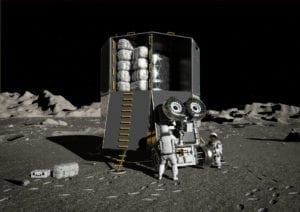by Jose Salgado

It’s no longer a matter of who arrives first but who stays the longest. A permanent human presence on the Moon is vital to create the lunar economy. This is what NASA’s Artemis program intends to do as early as 2024 at a cost of $30 billion.
By contracting private carriers and service providers, NASA is funding the company’s commercial capability to attract new customers with technology paid by the Agency. This model is the right governmental approach to foster a sustainable lunar ecosystem.
One of these examples is the Pittsburgh based company Astrobotic, calling themselves “the world leader in lunar logistics”, they have already secured 28 end-to-end payloads for lunar delivery, 14 of them by a $79.5 million award from the Commercial Lunar Payload Services (CLPS) for their Peregrine lander that will deliver payloads for $1.2 million per kilogram.
More recently the company also won a $199.5 million award from the CLPS to carry the Volatiles Investigating Polar Exploration Rover (VIPER) to the Moon on their Griffin lander. VIPER is a golf cart size rover that will drill up to 1m into the lunar surface looking for water, during its 100 days mission VIPER will collect samples and data to create the first water resource map on the Moon. Launching in the second half of 2023 on a ULA rocket.
About the role of Astrobotic in the lunar economy, CEO, John Thornton says: “The two lunar delivery contracts with NASA mark momentous milestones for Astrobotic and the space ecosystem as a whole. These missions represent the beginning of a new era of affordable, regular access to the lunar surface. Over time this unprecedented affordable access to the Moon will become the foundation for in-space fuel depots, planetary bases, and off-world resource utilization.”
However, China’s Chang Chang’e, India’s Chandrayaan 3, and more recently the Emirates Lunar Mission are also programs that intend to explore, extract, and potentially build on the moon. This is a positive scenario for a lunar economy, but it also forces us to ask, who owns the resources of the Moon?
According to Michelle L.D. Hanlon, Space Lawyer & Co-founder For All Moonkind, “it depends on what nation you are from. In the US and Luxembourg, if you mine it you own it. It’s anticipated that other nations are considering national legislation to this effect as well. Article II of the UN Outer Space Treaty mentions only that the Moon is not subject to national appropriation by claim of sovereignty, but it is silent with respect to the utilization of resources. Arguably, it is recognized that nations may take resources as both the US and Russia have returned resources from the Moon to Earth and no one objected. The counter-argument is that those resources were being used for scientific rather than commercial purposes.”
To support a sustainable lunar economy, we need clear regulatory instruments, a new international Treaty will be ideal but not feasible anytime soon. In the meantime, the United States is moving forward with the Artemis Accords that are bilateral agreements with seven signatories as of October 2020 (Australia, Canada, Italy, Japan, Luxembourg, United Arab Emirates, United Kingdom).
Although these Accords are only “intended to apply to civil space activities conducted by the civil space agencies of each Signatory”, it does touch on the use of space resources, saying: “The signatories affirm that the extraction of space resources does not inherently constitute national appropriation under Article II of the Outer Space Treaty and that contracts and other legal instruments relating to space resources should be consistent with that Treaty.”
In practice, the Artemis Accords do not contribute to a more substantial understanding of the legal framework for commercial activities in celestial bodies, and the wording is still open to interpretation. At the same time, these Accords seem to be open to ongoing consultation regarding its implementation as the final provisions of the Accords state: “Building on any consultative mechanisms in preexisting arrangements as appropriate, the signatories commit to periodically consult to review the implementation of the principles in these Accords, and to exchange views on potential areas of future cooperation.”

President of the Canadian Chamber in Italy, a Chamber 2.0 that focuses on innovation and new technologies. Honorary advisor to the Italian Intergovernmental committee for space. Columnist at COSMO magazine and Business Insider Mexico. Space Economy advisor.
Article first published in COSMO magazine and updated on October 14, 2020.
 SpaceWatch.Global An independent perspective on space
SpaceWatch.Global An independent perspective on space




